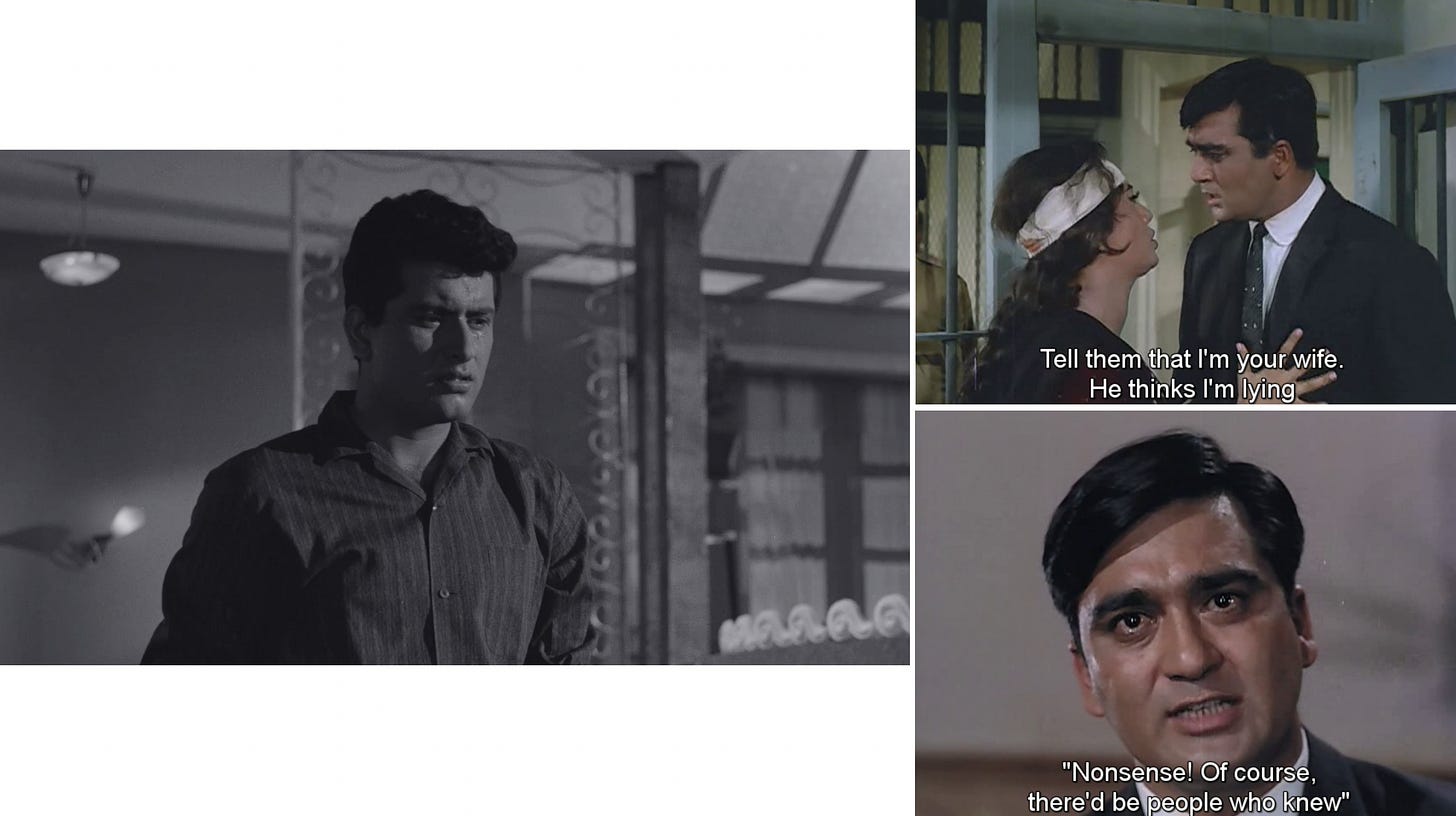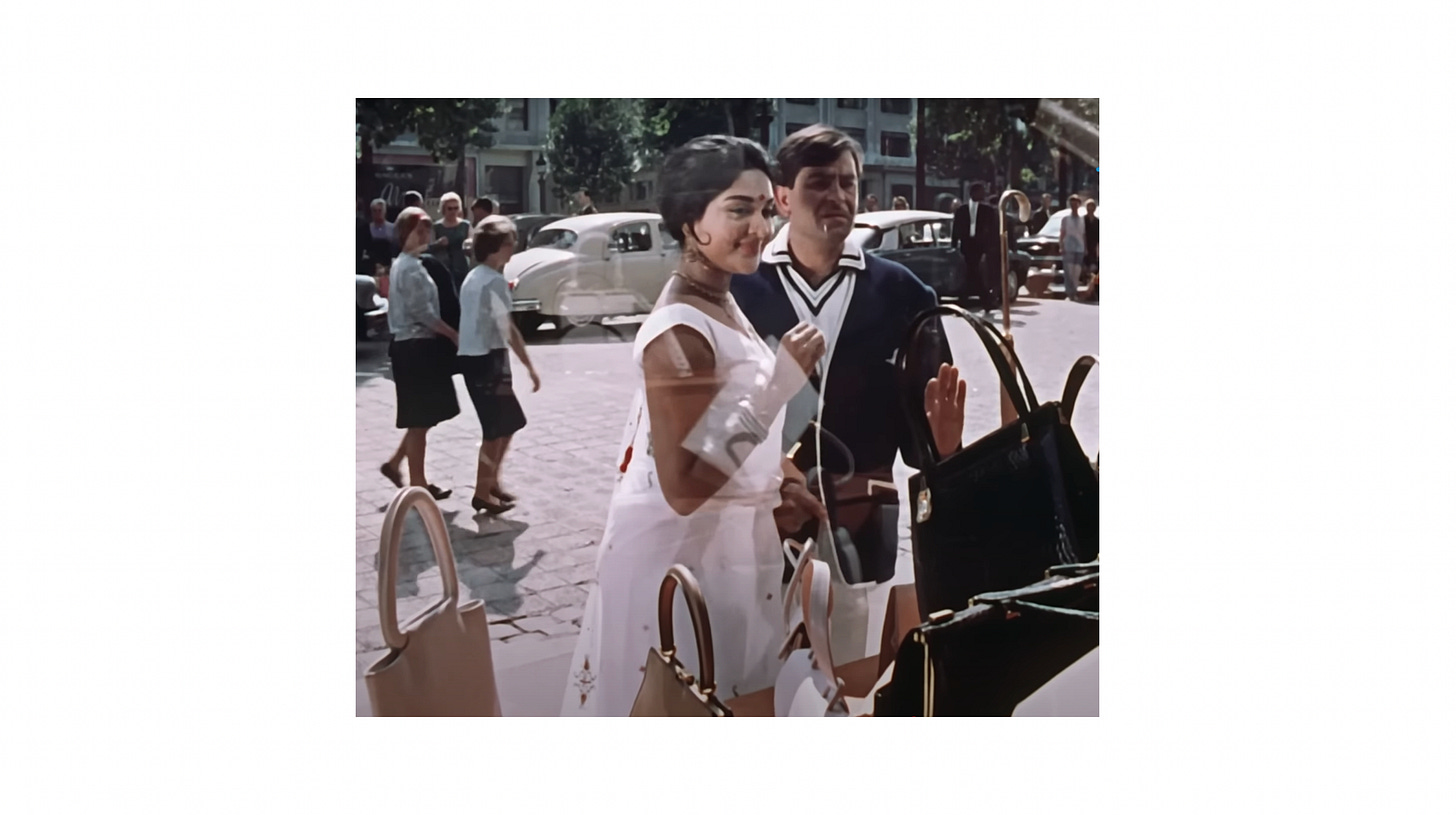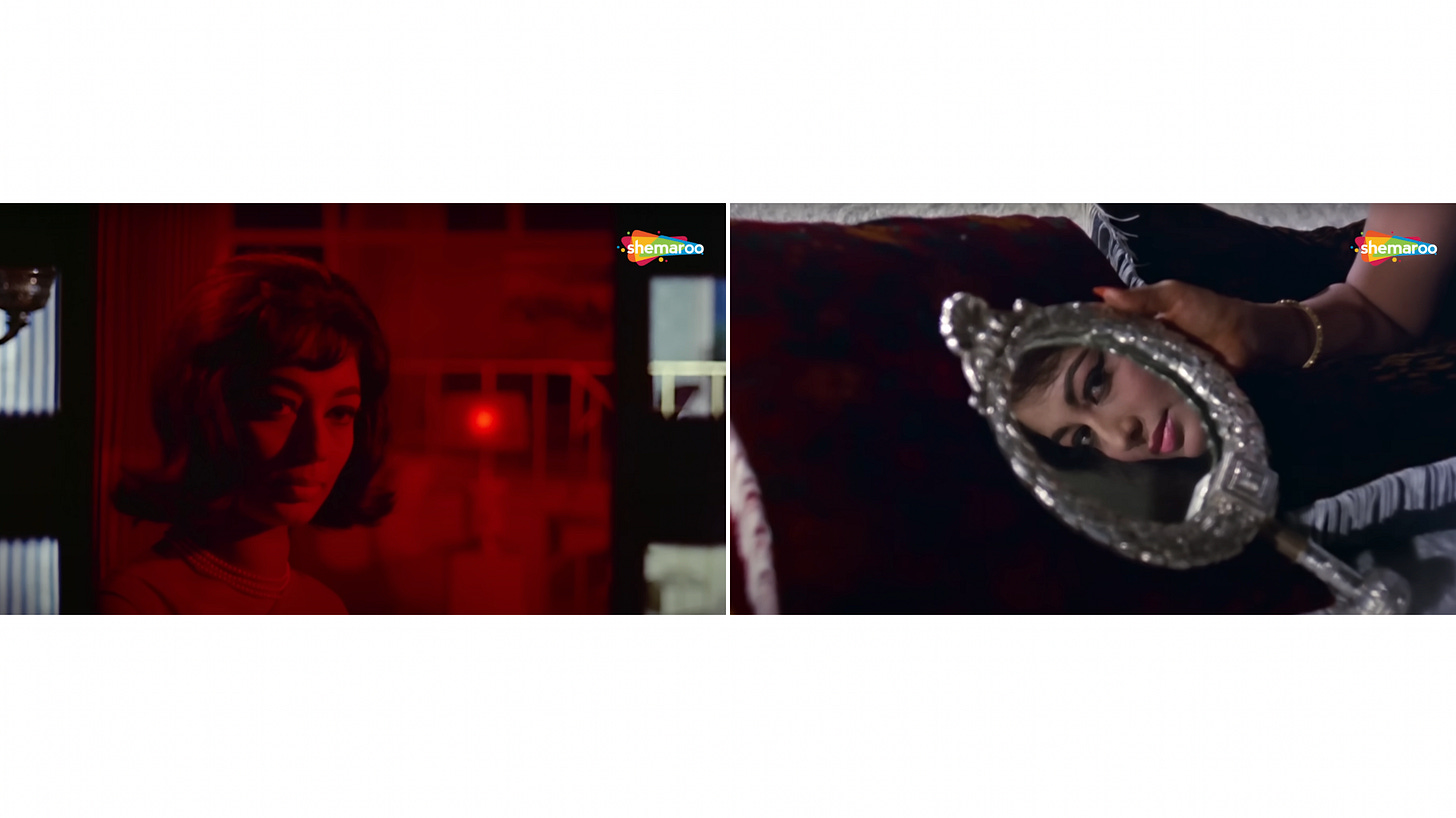Sadhana in a World of Flux: The Mystery Women of the 60s
Horror and the modern woman in 1960s Hindi cinema
(This article was originally published in Filmme Fatales Issue 7)
I first came across the film Woh Kaun Thi? ( Who Was She, 1964), a mystery-thriller film directed by Raj Khosla, through its haunting lamenting song, Naina Barse. My interest in the film was immediate. The film revolves around a wealthy heartbroken gentleman, grieving the sudden death of his girlfriend, played by Helen. Things get stranger when he meets a mysterious woman with an uncanny air about her who, interestingly we discover as the film progresses, resembles his wife. Sadhana Shivdasani plays the role of the wife as well as the mysterious doppelgänger. Clad in her white sari and sharp winged eyeliner, she resembles a mystifying vampire for most part of the film.

Khosla’s noir sensibilities, reminiscent of Hitchcock’s style of storytelling, positioned him outside of the Bollywood system I’d been exposed to before. My curiosity piqued, I sought out more of Khosla's films and discovered that Woh Kaun Thi? was part of a suspense trilogy, followed by Mera Saaya (My Shadow, 1966) and Anita (1967), all starring Sadhana as the enigmatic "mystery girl."
Sadhana entered the film industry at a very interesting point in the Hindi cinema’s evolution. Bollywood, as we know it, did not exist in the '60s. It was an era marked with a growing interest in the exploration of individual lives, rather than the nation as a whole (a preoccupation of the '50s). Popular films of this decade, such as Sangam (Raj Kapoor, 1964) and Jewel Thief (Vijay Anand, 1967), often focus on the modern young couple and the emergence of a commodity culture.
As a result, female characters became tremendously important in Hindi cinema during this period, with their roles expanding and their screen time increasing. The number of women joining the film industry rose, marking a shift from the past. Prior to the 1960s, women who chose to appear on screen were often courtesans, as the industry was considered disreputable. Things started to change, women from “respectable” families started to appear as the leading ladies.
Sadhana was one such actress, and her on-screen presence marked a significant breakthrough in mainstream cinema. She set some fashion trends, the most iconic being the fringe haircut, which is still popularly referred to as the “Sadhana cut” among Indians. She popularised churidars, a type of well-fitting cotton pyjama, once only popular among women from the Muslim community, into the mainstream.

Her face soon came to signify modernity and urbanism, and she came to stand for the woman of the now-somewhat-stablilised independent India. Her on screen characters represented the women who found anonymity and a sense of freedom in the cities, allowing them to forge new identities for themselves, professionally and socially. Once restricted to their homes, women were seen more and more in the public spaces of offices and markets, where they worked and interacted with men- something that, years earlier, only courtesans did. This was a cause of alarm for conservatives, because now it became impossible to judge a woman’s character. These anxieties played out on screen in films like Khosla’s suspense trilogy: Woh Kaun Thi, Mera Saaya, and Anita.

These films are about doppelgängers of a woman who has passed away, someone who was known for her purity and morality. The sudden appearance of the double throws up questions of identity, casting doubts on the character of the dead woman. It is interesting that Khosla repeatedly chose Sadhana for the films that made up the trilogy, exploring through her character the issues of property, women and marital life. The resolution in each film differs. Khosla worked with different writers for the three films and it makes me wonder if this is why we are offered differing motives and rationales for the confused identities and duality. It also tells us a lot about the changing nature of representation of women in Indian cinema.
The doppelgänger trope in the films enabled Sadhana to navigate complex character roles that defied simplistic good or bad categorisations, instead existing in a grey zone of shifting personalities. This kept viewers guessing, making it difficult to pin her down to a single persona. By juggling dual personas, Sadhana avoided the risk of being typecast as a "vamp" for the rest of her film career – a fate that befell many female actors of the time, including Helen and Bindu.
Browsing through Sadhana’s filmography on Wikepedia and IMDB, it becomes evident that she opted for roles that depicted women’s vulnerability, their reluctance to surrender, and their persistence to survive. In both Woh Kaun Thi and Mera Saaya, Sadhana masterfully portrays identical twins- one an idol of virtue, married, a respectable lady, while the other is her antithesis: a criminal with loose morals. The films unfold as suspenseful mystery thrillers, where a twist of fate switches the twins and their lives intertwine. Ultimately, both films end with the demise of the wayward twin, allowing the virtuous one to reintegrate into society.
Anita plays out differently. Unlike Woh Kaun Thi and Mera Saaya, the titular character, played by Sadhana, has no twin. Just twenty minutes into the film, we learn along with her boyfriend Neeraj (played by Manoj Kumar), that Anita has taken her own life. Skeptical, Neeraj begins investigating the circumstances surrounding her death. As he delves into her past, he meets the men she had been involved with, each recalling their encounters with her. There is a strong contrast between the Anita they remember and the one we had been introduced to in the film’s first half. Finally, it is revealed that Anita had been alive all along, forced into fabricating a fake identity and constructing a false past.
Raj Khosla skilfully employs elements of horror to express the pressing public concerns in this trilogy. The fragmented identity of the women, their past, and their roles in a rapidly changing Indian society, is one such concern. Another concern is the lingering influence of the zamindari system and the challenges of breaking from it. This is explored through the male leads, Anand and Rakesh (from Woh Kaun Thi and Mera Saaya, respectively), who, despite belonging to a noble class, must navigate the demands of a profession in independent India. Anand is a doctor, Rakesh a lawyer, while Anand inherits a vast property, Rakesh is a “Thakur” or nobleman who resides in an elegant lakeside mansion. Strangely, both men are oblivious to their wives’ pasts and have never met their families - a fact that becomes shockingly apparent even after their wives’ supposed deaths. The ensuing supernatural hauntings push these men to the brink of insanity, a crisis resolved only by the elimination of the malevolent twin, which serves to restore a semblance of the old world order.

In Woh Kaun Thi and Mera Saaya, Raj Khosla appears skeptical of the emerging modern Indian couple’s values in the 1960s. The traditional practice of arranged marriage, still prevalent in contemporary Indian society, was better suited to the older social setup. Unlike the cities, in small towns and villages, families knew each other’s histories, and anonymity was scarce. However, as this practice transitioned to modern, urban India, it became fraught with suspicion and doubt, particularly regarding a woman’s character and past. The strange events in these two films symbolise the disruption of the old order, highlighting the challenges of transitioning to modern values and suggesting that much remains to be learnt. (The conflict between love and arranged marriage remains a pervasive theme in Indian society, with the 2018 film Pari (Prosit Roy) revisiting this timeless dilemma, underscoring its enduring relevance across generations.)
Anita deviates significantly from the narrative of the previous two films. The story begins with Anita’s apparent suicide, prompted by her father’s disapproval of her relationship with Neeraj, a humble and honest newspaper writer. Unlike Anand and Rakesh, Neeraj is not a nobleman. Instead of passively grieving, he suspects foul play and actively investigates the strange occurrences by delving into Anita’s past. Furthermore, unlike Sandhya (Woh Kaun Thi) and Geeta (Mera Saaya), who are primarily portrayed as wives, Khosla gives us ample insight into Anita’s life in her own home, her own room and space. We see signs of an independent woman in her; she drives herself around, sports a short bob as a “modern” hip woman, and does not shy away from speaking her mind. Notably, she proposes a court marriage to Neeraj, choosing a progressive and unconventional approach over traditional Hindu ceremonies.
It’s intriguing to consider whether Khosla and Sadhana engaged in discussions about her character’s role and journey while collaborating on this trilogy, although I couldn’t find any credible sources to confirm this. Nevertheless, it’s reasonable to speculate that Sadhana’s influence may have contributed to Sadhana’s characters undergoing a significant evolution. From portraying Sandhya, a submissive wife who endures her husband’s insults, and Geeta, who remains silent to conceal her past, Sadhana’s transformation into Anita is striking. Anita is a strong-willed woman who resists her fate and fights to reunite with her lover, marking a notable shift in Sadhana’s on-screen personas.
Anita marks a deliberate departure from Raj Khosla’s familiar horror formula, as he reinvents the logic of suspense. By subverting audience expectations, Khosla portrays Anita as a victim of cruel lies and distorted male fantasies, effectively deconstructing the absurd notion of the “mystery woman” and the threat she poses. Instead, he seems to be suggesting that these perceptions stem from male anxieties triggered by women’s increasing presence in the public sphere- a subtle commentary that may have been unconscious to Khosla himself. Notably, Anita defies the tropes of her predecessors, Sandhya and Geeta, with no dual identity, evil twin or secretive past. By naming the film after her, Khosla shifts his focus from ghostly imagery to a fully realised female character. Ultimately, Anita’s survival until the end offers a glimpse of a more empowered and multidimensional female protagonist.
You can watch Woh Kaun Thi and Mera Saaya on Amazon Prime Video. Anita is available for free on Youtube.










